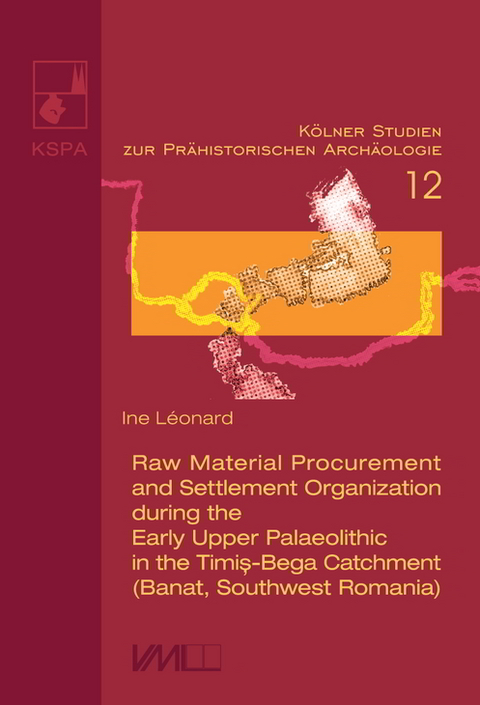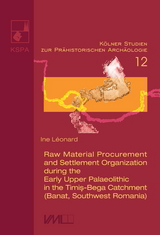Raw Material Procurement and Settlement Organization during the Early Upper Palaeolithic in the Timiş-Bega Catchment (Banat, Southwest Romania)
Seiten
2021
|
1., Aufl.
VML Vlg Marie Leidorf (Verlag)
978-3-86757-372-6 (ISBN)
VML Vlg Marie Leidorf (Verlag)
978-3-86757-372-6 (ISBN)
Nach “Pleistocene Archaeology of the Petra Area in Jordan” und “The Wadi Sabra” [KSPA 5 + 11] ist dies der 3. Band des DFG-Forschungsprojektes CRC 806 “Our Way to Europe”, der sich mit den Südkarpaten als bekanntem Hotspot der Anthropologie und Archäologie des frühen Spätpaläolithikums und den ältesten Nachweisen des modernen Menschen in der Knochenhöhle beschäftigt. Der Band präsentiert drei nahegelegene Freilandsiedlungen des Auriginacien in Tincova, Coşava und Româneşti-Dumbrăviţa. Diese zeigen viele Gemeinsamkeiten der Werkzeuge und ein Schweifgebiet von über 30 Wegstunden, aber Unterschiede bei Belegungsdauer und Mobilität, wobei die Höhensiedlung von Coşava die langlebigste war. Der erste Teil des Buches bietet einen Überblick über den Forschungsstand zur Einwanderung des Homo sapiens nach Europa und zu seiner Archäologie. Der zweite Teil enthält die Beschreibung der Befunde und Funde mit einem Fokus auf der Organisation und Taphonomie, einschließlich eines experimentellen Kapitels zu verwendeten Rohmaterialien, das ein neues Analyseprotokoll benutzt, bei dem lokale metallische Elemente als Hinweise auf Lagerstätten dienen.
After “Pleistocene Archaeology of the Petra Area in Jordan” and “The Wadi Sabra” [KSPA 5 + 11] this is the 3rd volume of the DFG research project CRC 806 “Our Way to Europe” dealing with the southern Carpathian Mountains that have long been known as a hotspot of Early Upper Palaeolithic anthropology and archaeology with earliest Modern Humans in Europe in Oase Cave. The author presents three nearby lowland settlements of the Aurignacian at Tincova, Coşava, and Româneşti-Dumbrăviţa. They showed many similarities in the toolkit and a roaming area of more than 30 hours walk, but different duration of occupation and mobility patterns, with the Coşava hilltop site being the most long-lived of the three. The first part of the book gives a thorough up-to-date overview of the current knowledge on the immigration of Homo sapiens into Europe and the connected archaeology. The second part contains the description of excavated sites and materials with a focus on organisational strategies and taphonomic history, including an experimental chapter on raw materials used involving a new protocol of analysis based on local metal elements identified as possible tracers of provenance. After “Pleistocene Archaeology of the Petra Area in Jordan” [KSPA 5] this is the 2nd book by the DFG research project CRC 806 “Our Way to Europe” - B1. The author, who participated in relevant field campaigns for many years, presents the first contextual and integrative account of the deep history of early occupation of now barren and overgrazed Wadi Sabra in SW-Jordan, where a once rich, green, and fertile landscape full of game provided many benefits to hunters. The study is concerned with creating an environmental reconstruction and a model of settlement dynamics for Wadi Sabra and an understanding of its great attraction. The text is tripartite, with part I explaining the research concept, part II presenting the material from 4 sites including detailed technical analyses and a cohesive cultural-historical interpretation of the local development, and part III broadening this picture to the Southern Levant in an attempt to reconstruct settlement patterns and mobility from all available inventories in a diachronic perspective. What was found was a stable residential mobility system with a highly diverse technology and typology in the Upper Palaeolithic which was only homogenised in the Epipalaeolithic.
After “Pleistocene Archaeology of the Petra Area in Jordan” and “The Wadi Sabra” [KSPA 5 + 11] this is the 3rd volume of the DFG research project CRC 806 “Our Way to Europe” dealing with the southern Carpathian Mountains that have long been known as a hotspot of Early Upper Palaeolithic anthropology and archaeology with earliest Modern Humans in Europe in Oase Cave. The author presents three nearby lowland settlements of the Aurignacian at Tincova, Coşava, and Româneşti-Dumbrăviţa. They showed many similarities in the toolkit and a roaming area of more than 30 hours walk, but different duration of occupation and mobility patterns, with the Coşava hilltop site being the most long-lived of the three. The first part of the book gives a thorough up-to-date overview of the current knowledge on the immigration of Homo sapiens into Europe and the connected archaeology. The second part contains the description of excavated sites and materials with a focus on organisational strategies and taphonomic history, including an experimental chapter on raw materials used involving a new protocol of analysis based on local metal elements identified as possible tracers of provenance. After “Pleistocene Archaeology of the Petra Area in Jordan” [KSPA 5] this is the 2nd book by the DFG research project CRC 806 “Our Way to Europe” - B1. The author, who participated in relevant field campaigns for many years, presents the first contextual and integrative account of the deep history of early occupation of now barren and overgrazed Wadi Sabra in SW-Jordan, where a once rich, green, and fertile landscape full of game provided many benefits to hunters. The study is concerned with creating an environmental reconstruction and a model of settlement dynamics for Wadi Sabra and an understanding of its great attraction. The text is tripartite, with part I explaining the research concept, part II presenting the material from 4 sites including detailed technical analyses and a cohesive cultural-historical interpretation of the local development, and part III broadening this picture to the Southern Levant in an attempt to reconstruct settlement patterns and mobility from all available inventories in a diachronic perspective. What was found was a stable residential mobility system with a highly diverse technology and typology in the Upper Palaeolithic which was only homogenised in the Epipalaeolithic.
| Erscheinungsdatum | 14.12.2021 |
|---|---|
| Reihe/Serie | Kölner Studien zur Prähistorischen Archäologie ; BD 12 |
| Verlagsort | Rahden/Westf. |
| Sprache | englisch |
| Maße | 210 x 297 mm |
| Gewicht | 910 g |
| Einbandart | gebunden |
| Themenwelt | Geschichte ► Allgemeine Geschichte ► Vor- und Frühgeschichte |
| Schlagworte | Pleistozän • Rohstoff • Siedlungsarchäologie • Silex • Taphonomie • Umwelt |
| ISBN-10 | 3-86757-372-7 / 3867573727 |
| ISBN-13 | 978-3-86757-372-6 / 9783867573726 |
| Zustand | Neuware |
| Haben Sie eine Frage zum Produkt? |
Mehr entdecken
aus dem Bereich
aus dem Bereich
auf den Spuren der frühen Zivilisationen
Buch | Hardcover (2023)
C.H.Beck (Verlag)
CHF 27,95
Was Pompeji über uns erzählt
Buch | Hardcover (2023)
Propyläen (Verlag)
CHF 44,75




